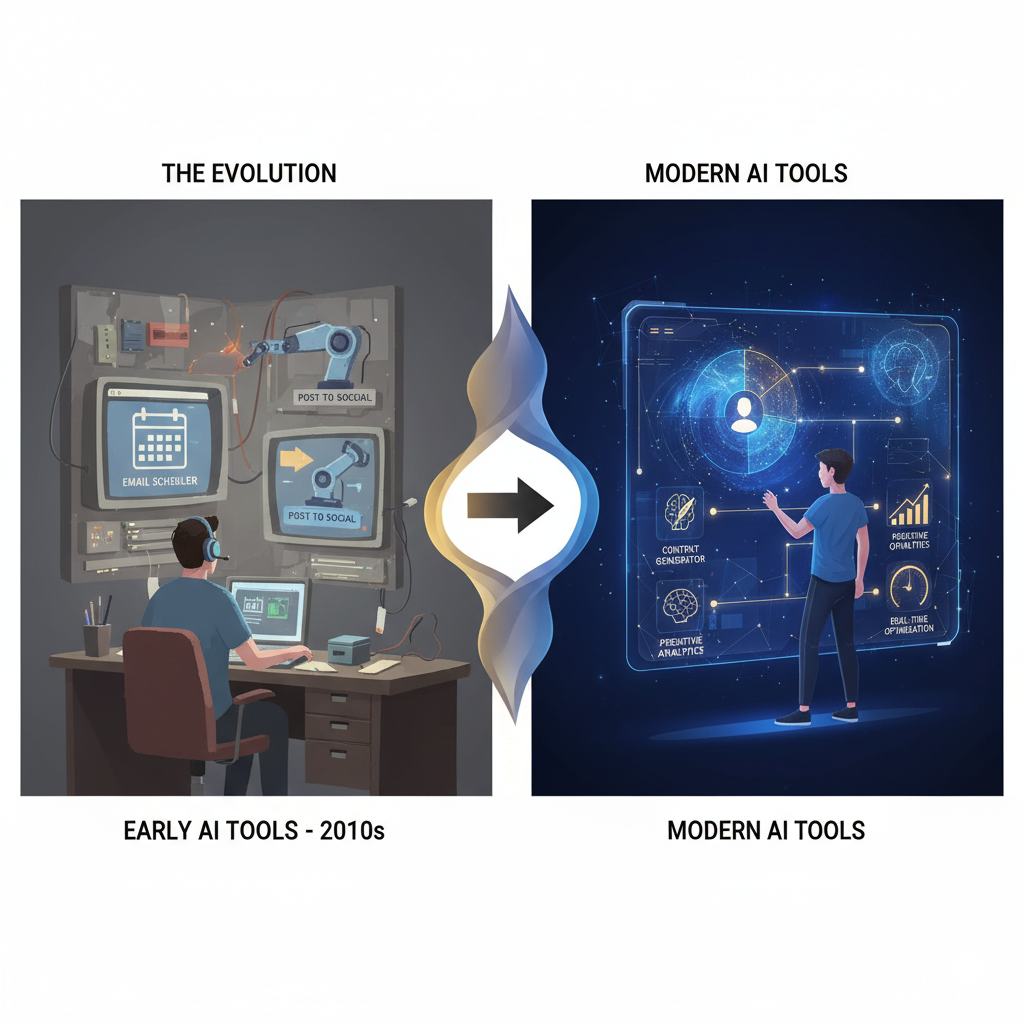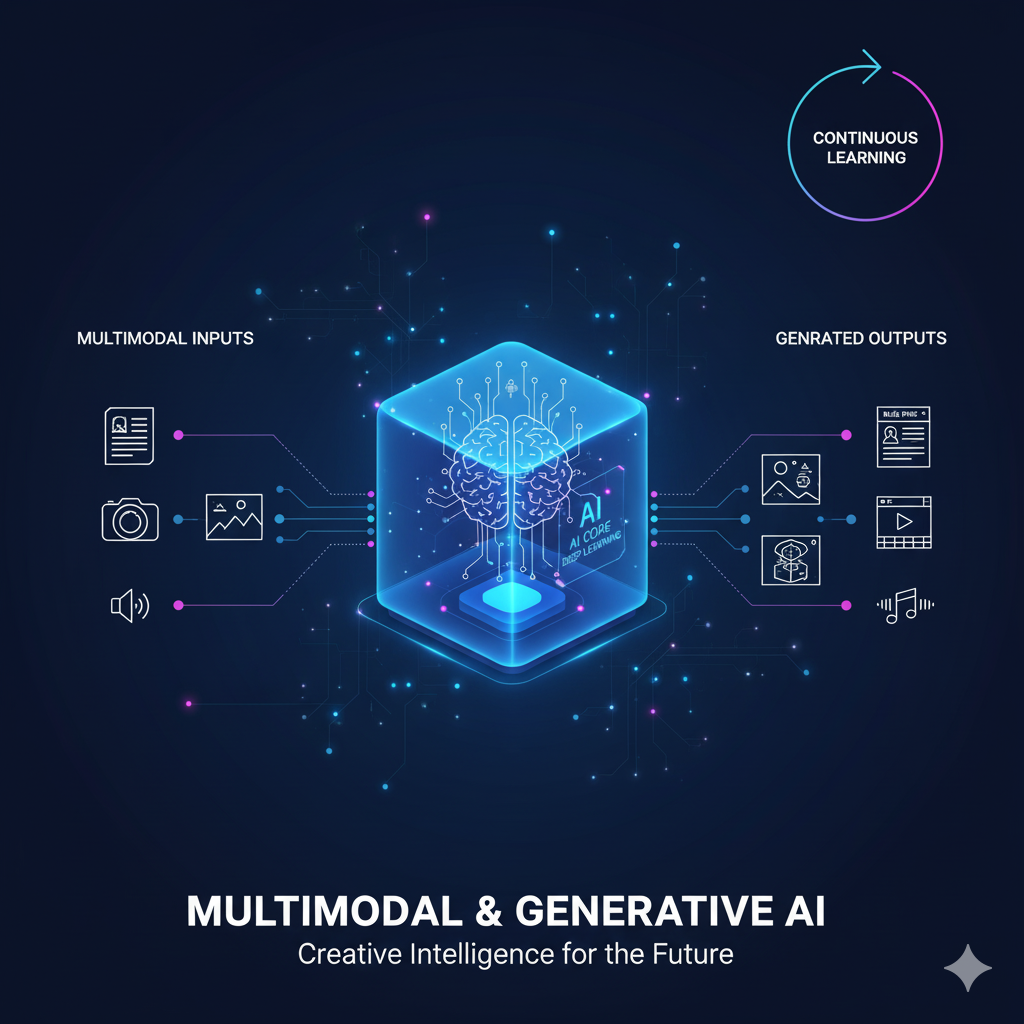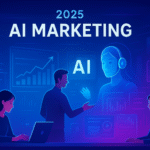Introduction
In 2025, artificial intelligence (AI) is changing the way marketing works. Marketers are using AI tools to save time, reach more people, and create better customer experiences. With so many channels and so much data, it’s hard for humans alone to keep up. AI helps marketers do more with less—launching campaigns faster, personalizing messages, and proving results. This guide explains how AI is transforming marketing, from its evolution to the core functions and top tools you should know.
The Evolution of AI in Marketing
AI in marketing has come a long way. Years ago, marketers used simple automation tools to schedule emails or post on social media. These tools followed basic rules and didn’t learn or adapt. Today, AI-powered platforms use machine learning and deep learning to analyze huge amounts of data, predict trends, and personalize content for each customer.
-
- Early AI tools: Focused on automating repetitive tasks, like sending emails or sorting leads.
- Modern AI tools: Use advanced algorithms to understand customer behavior, generate content, and optimize campaigns in real time.
- Key milestones:
-
- Machine learning models can now predict what customers want before they ask.
- AI can process millions of data points instantly, helping marketers tweak campaigns on the fly.
- Generative AI creates blog posts, social media updates, and even videos with minimal human input.
AI has shifted marketing from guesswork and manual effort to data-driven, automated, and highly personalized strategies. Marketers can now react to customer needs instantly and even predict what will work best in the future.
Core Functions of AI Marketing Tools
AI marketing tools do much more than automate tasks. They help marketers understand their audience, create better content, and improve results. Here are the main functions:
- Data Collection and Analysis: AI gathers data from websites, social media, emails, and more. It finds patterns and insights that humans might miss.
- Predictive Analytics: AI predicts customer behavior and campaign performance, helping marketers make smarter decisions.
- Automated Content Generation: Tools like Jasper and Copy.ai can write blog posts, emails, and social media updates automatically.
- Personalization and Segmentation: AI divides customers into groups and tailors messages for each one, increasing engagement and conversions.
- Sentiment Analysis and Social Listening: AI scans social media and reviews to understand how people feel about a brand or product.
- Real-Time Optimization and A/B Testing: AI tests different versions of ads or emails and picks the best one, improving results quickly.
- Multichannel Integration: AI connects marketing efforts across email, social media, websites, and more, making campaigns seamless.
- Chatbots and Conversational Marketing: AI-powered chatbots answer questions, recommend products, and guide customers through purchases.
- SEO Optimization and Keyword Research: AI finds the best keywords and helps marketers improve their search rankings.
- Ad Targeting and Budget Optimization: AI targets ads to the right people and manages spending for maximum return.
These functions help marketers work faster, smarter, and more effectively. AI tools can handle tasks that used to take hours or days, freeing up marketers to focus on strategy and creativity.
Top AI Marketing Tools in 2025
There are many AI marketing tools available, each with its own strengths. Here are some of the top platforms to know in 2025:
- Gumloop: Gumloop is best known for automating social media and content creation tasks. It helps marketers schedule posts, generate captions, and even create graphics automatically, saving time and keeping your brand active online.
- Surfer SEO: Surfer SEO is a powerful tool for optimizing website and blog content. It uses AI to suggest keywords, analyze competitors, and provide real-time feedback on your writing, helping you rank higher in search engines.
- Jasper AI: Jasper AI specializes in generating high-quality marketing copy, blog posts, and emails. It’s great for marketers who need fresh ideas or want to speed up content creation with AI-powered writing templates.
- Notion AI: Notion AI adds smart features to the popular productivity app Notion. It helps with project management, note-taking, and content generation, making it easier for marketing teams to organize ideas and draft materials.
- Crayo: Crayo focuses on creative content generation, especially short-form videos and images. Marketers use it to quickly produce engaging visuals for social media and ads without needing advanced design skills.
- Brandwell: Brandwell uses AI to manage brand reputation and monitor social sentiment. It scans online mentions, reviews, and social media to help marketers understand how people feel about their brand and respond quickly to feedback.
- ActiveCampaign: ActiveCampaign is an AI-powered email marketing and automation platform. It helps marketers automate customer journeys, score leads, and send personalized emails at the best times for engagement.
- Lindy: Lindy is an AI assistant for campaign management and analytics. It helps marketers track campaign performance, analyze data, and get actionable insights to improve results.
- Bïrch: Bïrch specializes in AI-driven personalization and customer segmentation. It divides audiences into groups and tailors marketing messages for each segment, boosting engagement and conversions.
- Trapica: Trapica uses machine learning to optimize ad targeting and budget allocation. It automatically adjusts who sees your ads and how much you spend, helping you get better results from your advertising budget.
- BrazeAI: BrazeAI enhances customer engagement through personalized messaging. It analyzes customer data to send the right message at the right time, improving retention and loyalty.
- Zapier: Zapier connects different marketing tools and automates workflows using AI. It lets marketers build custom automations—like sending leads from a form to an email list or posting new blog articles to social media—without any coding.
Each of these tools has its own strengths, so marketers often combine several to cover all their needs—from content creation and SEO to automation and analytics.
How to Choose the Right AI Marketing Tool: A Step-by-Step Guide
Selecting the best AI marketing tool isn’t just about picking the most popular platform—it’s about finding what fits your unique business needs, goals, and resources. Here’s how to make a smart, confident choice in 2025:
Consider Your Business Size, Goals, and Budget
- Business Size: Small teams may need simple, user-friendly tools, while larger organizations might require advanced features, deeper customization, and robust support. For example, a small business might benefit from a tool like Lumen5 for quick video creation, while an enterprise could need Adobe Sensei for more complex campaigns.
- Goals: Start by identifying your marketing objectives. Are you looking to automate email campaigns, improve ad targeting, generate content, or analyze customer data? Clear goals help you focus on tools that solve your biggest pain points.
- Budget: Balance the cost of the tool against the potential return on investment (ROI). Consider not just the subscription price, but also onboarding, training, and integration costs. Many tools offer free trials or tiered pricing—test features before committing long-term.
Look for Tools That Integrate with Your Existing Systems
- Seamless Integration: The best AI tools should work smoothly with your current marketing stack—like your CRM, email platform, analytics tools, or e-commerce system. This ensures data flows easily and you avoid manual work or data silos.
- Workflow Compatibility: Choose tools that enhance, not disrupt, your existing processes. For example, if your team already uses HubSpot, look for AI tools that integrate directly with it for smoother automation.
- Data Quality: Make sure your chosen tool can access accurate, comprehensive data from your systems. Good data is essential for AI to deliver useful insights and results.
Test Free Trials to See Which Platform Fits Your Workflow
- Hands-On Testing: Most leading AI marketing tools offer free trials or demo accounts. Use these to test real marketing scenarios—like creating a campaign, segmenting audiences, or generating content—rather than just exploring generic features.
- Usability: Evaluate how intuitive the interface is, how easy it is to navigate, and whether your team can use it without extensive training.
- Scalability: Consider whether the tool can grow with your business. Can it handle more users, larger campaigns, or new channels as you expand?
Read Reviews and Case Studies to Learn How Others Use These Tools
- Peer Insights: Check expert reviews, user testimonials, and independent rankings to see how the tool performs in real-world situations.
- Case Studies: Look for examples from businesses similar to yours. See what results they achieved, what challenges they faced, and how the tool fit into their workflow.
- Support and Community: Consider the quality of vendor support, training resources, and user communities. Good support can make a big difference in successful adoption.
Each tool offers unique features, so it’s important to match your needs with the right solution. Some tools focus on automation, while others excel at personalization, analytics, or creative content. The best AI marketing stack often combines several tools for maximum impact.
Real-World Applications and Case Studies
AI tools are now deeply woven into marketing strategies across industries. Let’s look at how brands are using AI in real life:
- Sentiment Analysis and Competitor Intelligence: Brands use AI to scan social media, reviews, and forums to understand how customers feel about their products and what competitors are doing. This helps marketers quickly spot trends, address negative feedback, and adjust their messaging in real time.
- Automating Creative Workflows: AI-powered tools like Jasper and Crayo generate blog posts, video scripts, product descriptions, and even images or videos. This speeds up content production, ensures brand consistency, and allows teams to focus on strategy and creativity instead of repetitive tasks.
- AI-Powered Email Marketing: Platforms such as ActiveCampaign and BrazeAI use AI to predict the best time to send emails, score leads, and map out customer journeys. This means higher open rates, better engagement, and more conversions with less manual effort.
- CRM and Marketing Automation: AI-driven CRMs segment audiences, personalize messages, and automate follow-ups. Marketers can manage entire campaigns from one dashboard, track results, and optimize in real time.
- Ad Campaign Optimization: Tools like Trapica use machine learning to target ads to the right people, adjust bids automatically, and test different creative versions. This leads to better ROI and more effective ad spend.
- Personalization at Scale: AI enables brands to recommend products, personalize website content, and deliver dynamic offers to each visitor. This level of personalization was impossible before AI and leads to higher customer satisfaction and loyalty.
Example:
A global e-commerce brand used AI to analyze customer behavior and personalize product recommendations. As a result, they saw a 4% increase in conversion rates and a 93% decrease in customer service wait times.
Benefits of AI in Marketing
AI is transforming marketing by delivering clear, measurable benefits:
- Increased Efficiency: AI automates repetitive tasks like data entry, A/B testing, and customer segmentation. This frees up marketers to focus on strategy, creativity, and innovation, and speeds up campaign launches.
- Better Customer Insights: AI can analyze huge amounts of data to find patterns and trends that humans might miss. This leads to a deeper understanding of audiences and more informed marketing strategies.
- Enhanced Personalization: AI tailors emails, ads, and website content to each user, improving engagement and loyalty. Personalized onboarding, loyalty programs, and upsell flows are now all driven by AI.
- Improved ROI: By targeting the right audiences and optimizing campaigns in real time, AI helps businesses get more value from their marketing budgets. This means lower costs per acquisition and higher customer lifetime value.
- Scalability: AI allows small teams to run large, complex campaigns that would otherwise require much more staff. This levels the playing field for smaller businesses.
- Innovation and Creativity: AI tools can suggest new ideas, test creative variations, and help marketers experiment with new formats and channels.
Challenges and Limitations
While AI offers many advantages, it also brings new challenges for marketers:
- Data Privacy and Ethical Use: AI relies on large amounts of data, so brands must be transparent about how they collect and use customer information. Compliance with laws like GDPR and CCPA is essential, and marketers must address concerns about algorithm bias and fairness.
- High Initial Investment: Setting up AI systems can be expensive and time-consuming, especially for small businesses. Training, integration, and ongoing management require resources, though SaaS-based AI platforms are making entry easier.
- Over-Reliance on Automation: Relying too much on AI can lead to a loss of human touch. Marketers still need to provide strategic direction, creativity, and empathy to connect with audiences.
- Data Quality Issues: AI is only as good as the data it uses. Incomplete or poor-quality data can lead to bad predictions and poor customer experiences. Marketers must invest in data cleaning and management.
- Integration with Existing Systems: Connecting AI tools to legacy systems or other marketing platforms can be complex and may require technical expertise.
- Skills Shortage: There is a growing need for marketers who understand both AI and marketing. Training and upskilling are essential for successful adoption.
- Unclear ROI: Measuring the return on investment for AI initiatives can be difficult, especially in the early stages. Marketers need clear goals and tracking to justify spending.
- Ethical and Legal Concerns: Issues like deepfakes, copyright infringement, and algorithmic bias require careful oversight and responsible use of AI.
Future Trends in AI Marketing
AI is not just changing marketing today—it’s shaping the future in ways that will impact every business, big or small. Here are the most important trends to watch as we move further into 2025 and beyond:
Hyper-Personalization at Scale
AI is making it possible to personalize marketing messages for each individual customer, not just broad segments. Algorithms analyze browsing behavior, device type, location, and even time of day to deliver content that feels tailor-made. Recommendation engines, like those used by Netflix and Amazon, suggest products or content before customers even know they want them. In fact, 92% of businesses now use AI-driven personalization, and personalized calls to action outperform generic ones by over 200%.
What this means for marketers:
- Customers expect brands to understand their needs and deliver relevant experiences.
- Businesses must balance personalization with privacy, offering clear opt-in choices and transparent data practices.
- Hyper-personalization drives loyalty, higher conversion rates, and long-term growth.
AI-Driven Automation for Efficiency and Productivity
AI is automating more marketing tasks than ever before—from content creation and email scheduling to ad bidding and customer service. 92% of marketers say automation is key to staying competitive, and 96% have used automation platforms in some part of their business.
Benefits include:
- Marketers can focus on strategy and creativity, not repetitive tasks.
- Automation platforms increase leads, cut costs, and improve ROI.
- Chatbots and virtual assistants handle initial customer inquiries, freeing up staff for complex issues.
- AI can auto-generate subject lines, optimize delivery times, and trigger follow-ups based on customer behavior.
Advanced Data Analytics and Predictive Insights
AI tools now analyze both structured and unstructured data—like images, videos, and social media posts—to uncover deep insights about consumer preferences and brand perception. Predictive analytics allow marketers to anticipate what customers want and deliver content before they even ask for it.
Key impacts:
- Marketers can react to trends instantly and even predict future demand.
- Data-driven decisions replace guesswork, improving campaign performance.
- Real-time optimization and A/B testing become standard practice.
Multimodal and Generative AI
Generative AI is maturing, allowing marketers to create text, images, videos, and even audio content with minimal effort. The global generative AI market is expected to reach $356 billion by 2030, growing at a CAGR of over 41%. Multimodal AI tools can process and generate content across different formats, making campaigns more engaging and versatile.
What to expect:
- Faster content production and creative experimentation.
- More immersive and interactive marketing experiences.
- Small businesses can compete with larger brands by leveraging affordable generative AI tools.

Voice Search, Social Search, and Visual Search
AI is powering new ways for customers to discover brands and products. Voice search optimization, social search, and AI-driven visual search are becoming essential for marketers.
Why it matters:
- Customers use voice assistants and social platforms to find information.
- Visual search lets users find products by uploading images, making shopping easier and more intuitive.
- Marketers must optimize content for these new search methods to stay visible.
Regulatory, Privacy, and Ethical Considerations
As AI marketing grows, so do concerns about data privacy, ethics, and brand safety. Nearly half of businesses implementing AI are concerned about consumer privacy or ethics, and 49.5% have data privacy concerns.
What marketers need to do:
- Prioritize transparency and user control over data.
- Address biases and inaccuracies in AI-generated content.
- Stay compliant with regulations like GDPR and CCPA.
Agentic AI and Autonomous Marketing Workflows
Agentic AI tools—”digital employees” that automate complex, multi-step processes—are becoming mainstream. These tools can handle customer support, document processing, and sales outreach with minimal human intervention. Pricing models are evolving to charge per agent, workflow, or outcome, making advanced automation accessible to small businesses.
Key takeaways:
- Advanced automation is now available to everyone.
- Expect more tools that learn and adapt to your business over time.
- Workflow-based and outcome-based pricing models are emerging.
Continuous Improvement and Rapid Feature Updates
AI tools are updating faster than ever, with new features and integrations rolling out monthly or weekly. This rapid pace is driven by competition, customer demand, and modular architectures.
What this means:
- Stay informed about updates to maximize value.
- Early adopters benefit from cutting-edge features but must manage change.
- Vendor support and documentation are more important than ever.
The Growing Importance of Training and Change Management
While 88% of digital marketers use AI daily, 70% say their employer doesn’t provide generative AI training. To maximize AI’s value, marketers need ongoing education and support.
Action steps:
- Invest in training and upskilling for your team.
- Encourage experimentation and share best practices.
- Build a culture of continuous learning and adaptation.
How to Get Started with AI Marketing Tools
Ready to embrace AI in your marketing? Here’s a simple roadmap:
- Assess your needs and goals: Identify which marketing tasks could benefit most from AI—content creation, personalization, analytics, or automation.
- Build your AI marketing stack: Start with affordable, user-friendly tools that integrate with your existing systems. Test free trials and compare features.
- Train your team: Provide role-specific training and encourage hands-on experimentation. Address concerns and highlight early wins.
- Manage change: Communicate the benefits of AI, set clear expectations, and gather feedback to refine your approach.
- Measure success: Track key metrics like efficiency, ROI, engagement, and customer satisfaction. Use AI-powered reporting to spot opportunities and optimize campaigns.
Conclusion
AI tools are revolutionizing marketing by making it smarter, faster, and more personalized than ever before. From hyper-personalization and automation to predictive analytics and generative content, the future of marketing is powered by AI. To stay ahead, marketers must embrace change, invest in training, and prioritize ethical, data-driven strategies. By doing so, you’ll unlock new levels of creativity, efficiency, and growth for your brand in 2025 and beyond.




